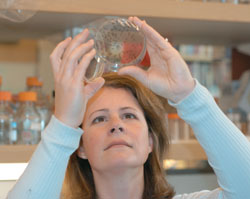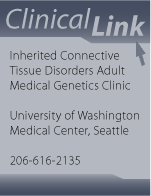Brittle Bone Disease
Scientists a major step closer to gene therapy for osteogenesis imperfecta
Their bones can break from everyday acts as simple as coughing, or turning over while asleep. People with osteogenesis imperfecta, known as brittle bone disease, have mutations that cause their bodies to either produce abnormal type I collagen, the major protein in bone, or too little of the collagen. As a result, people with brittle bone disease often have skeletal abnormalities, short stature, and bones that can break easily, as well as dental and hearing problems.
Though brittle bone disease is uncommon, occurring once in every 12,000 births, it is devastating to its victims. A group of UW researchers is working on a treatment for severe forms of the disorder.
They developed a targeted gene therapy that eliminated in adult stem cells the genetic mutations associated with osteogenesis imperfecta. The group, led by Dr. David Russell, associate professor of medicine in the Division of Hematology, and Dr. Peter Byers, professor of pathology and of medicine and adjunct professor of genome sciences, had its research results published in the Feb. 20, 2004 issue of the journal Science. The study's lead author was Dr. Joel Chamberlain, a senior fellow in hematology and a researcher in Russell's lab.
 |
| Dr. Joel Chamberlain led a study that eliminated, in adult stem cells, the genetic mutations associated with brittle bone disease. |
Researchers used a method of viral vector gene targeting, which was developed by Russell's group. They disrupted one copy of the mutant collagen gene in stem cells taken from the bones of people with osteogenesis imperfecta.
"A virus takes the DNA, which acts like a switch, and inserts it into one of the two copies of the collagen gene and turns it off," Byers explained.
The gene targeting successfully turned off the mutant copy of the gene in the bone stem cells. In addition, the collagen protein produced by those stem cells had improved assembly and stability necessary for bone strength, as shown by researchers Dr. Ulrike Schwarze and Dr. James Pace in Byers' group, and the cells were capable of forming bone when implanted later in mice.
In the more severe form of brittle bone disease, in which abnormal collagen is produced by one of the two mutant genes, such therapy could help reduce the severity of the disease. The normal copy of the gene keeps working after the mutant gene is turned off, thereby allowing the body to produce half the normal amount of collagen and turning the severe form of the disease into a milder case.
Using gene therapy to treat the disease in humans will probably take a while, Russell predicted, because of issues in delivering the cells to their home in the bone, where they would replace the mutant bone-forming cells already present, and form enough normal bone for a therapeutic effect. Additional animal studies addressing these questions will be necessary before the approach will be ready for clinical assessment.
Researchers plan to extend the studies to COL1A2, another collagen gene affected in osteogenesis imperfecta, because such a therapy could leave people free of bone disease.
Russell was pleased that the team was able to create such an effective method of targeted gene therapy. Previous methods inserted the corrected gene randomly on the genome. This inaccurate placement rendered it useless or even activated cancer-causing genes.
"I think one of the important outcomes of this study is not just its potential for treating osteogenesis imperfecta, but that we can target a specific gene in its normal chromosomal position in a human stem cell," Russell said.
The researchers hope that their method of gene targeting will help not just in the treatment of brittle bone disease, but also in other genetic disorders.
